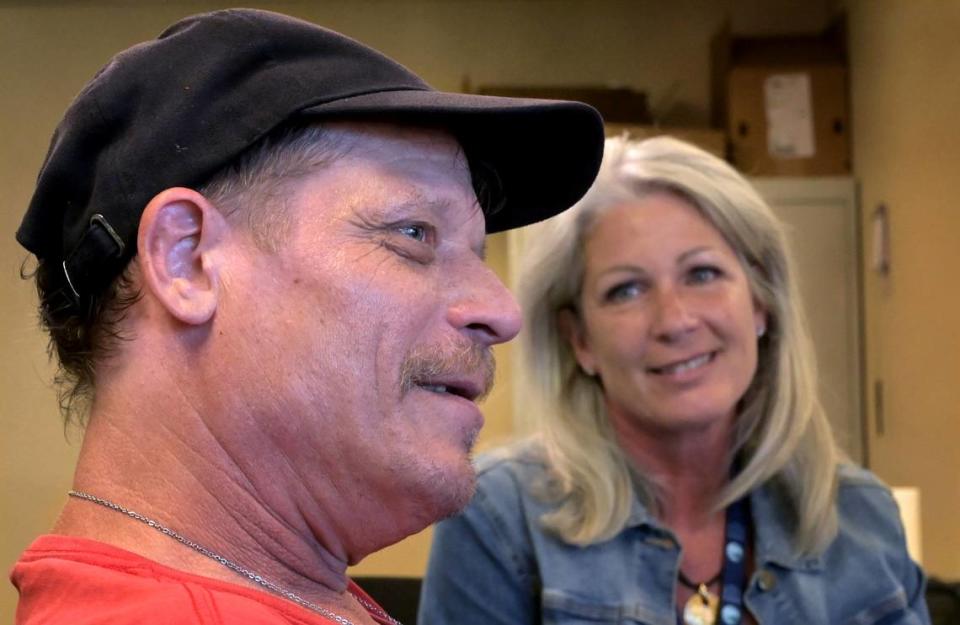This Thurston County jail diversion program makes ‘world of difference’ for those in need
Sebastian Soto spent most of his adulthood coming and going from jail due to an untreated alcohol addiction. Within 10 years, he said he got caught driving under the influence four times, making him a felon.
After his last release in December 2021, Soto entered a new Thurston County program that would help him get his life back on track.
“The LEAD program became a vital aspect to my success in the community,” Soto said. “I knew I didn’t ever want to return (to jail) but in doing so I needed help. Becoming sober, doing the right things and applying myself were just the beginning.”
LEAD stands for Law Enforcement Assisted Diversion. The county launched their version of this program in July 2021. With a small team in a county of over 300,000 people, the program’s reach has been relatively limited. Yet, it’s still helped hundreds of people with unmet needs avoid prosecution and improve their lives in ways big and small.
The program works by connecting people with peer case managers who help them overcome their personal challenges. In Soto’s case, he said his case manager helped him set goals, get treatment for his alcohol addiction, apply for jobs and more.
“Having someone there to help you and be a part of what you needed to get done, the support from that, the fellowship that you obtain, it makes a world of difference,” Soto said.
At 37, Soto is still part of the LEAD program, but he’s made progress. He said he has a fiancé, two daughters and a seasonal maintenance job at the City of Olympia Public Works Department.
Soto said he used to feel like taking advantage of opportunities had a negative connotation, but he’s since realized it’s OK to accept help.
“You are allowed to take advantage of certain gifts to obtain goals in your life, that are going to put you in better places,” Soto said. “Absolutely, I’m all for it. I never knew the difference until today.”
LEAD Program Manager Jason Bean-Mortinson said most participants tend to stabilize and transition out of services in about six months, but others have stayed for longer or chosen to return.
The program is focused on a “harm reduction” approach, meaning they strive to limit any suffering by the participant or community. At the end of the day, he said it’s about saving people’s lives.
“I think one of the goals is really to have no judgment,” Bean-Mortinson said. “It’s about showing up where you’re at and helping you get what you need.”
Referrals to get someone into the program can come from various sources. Soto said his referral came from his probation officer, making it a criminal legal system referral.
Referrals also can be handed out by community partners and outreach services. Such was the case for Donald Collins, 54.
Collins said he felt like he hit rock bottom about two years ago. He was suffering from alcohol addiction and sleeping in his car after separating from his partner.
Over a year ago, he encountered a case manager for the LEAD program at a local recovery home. The case manager offered him a referral and in a few months’ time he was getting help.
“We’d sit down, and we’d discuss avenues like programs out there that would help,” Collins said. “You have to get a referral to get into these things. It’s not easy sometimes. But what (LEAD) does, it helps you open up the door for those programs to get into.”
Now, he’s sober, living in group home and looking for work. However, it took some work to get there. Though he’s relapsed a couple times, he said his case manager continued to encourage him.
“If I didn’t take advantage of it, I would have been in a worse place,” he said.

The scale of caseload
Nicole Smith, 56, is a peer case manager who joined the program almost two years ago. Like others in her position, she has lived experience that’s relatable to participants.
“After coming into recovery myself, my life totally changed when I realized through that life event that I didn’t have to live my old life again,” Smith said.
Typically, she has between 15 and 25 people on her caseload who are at various stages of need. Some of them she only connects with weekly, while others need much more frequent contact.
She said the work is challenging and requires plenty of patience, especially given the limited resources in the community, but it’s still worth it.
“I think it’s the greatest program because it’s life changing,” Smith said. “And it has that trickle-down effect. It’s not just the person that we’re directly working with, but all the people that person comes in contact with, it benefits them as well.”
The Thurston Mason Behavioral Health Administrative Service Organization manages the program and Olympic Health and Recovery Services provides case management services.
The program partners with local law enforcement and the Prosecuting Attorney’s Office, which issue arrest diversion referrals. A Community Advisory Board, Steering Committee and Operations work group oversee the program.
Bean-Mortinson said the program has seven case managers and two substance use disorder professionals who help coordinate outreach, conduct intake and assess participants.
He acknowledged the staff is not large enough to support all the people in Thurston County who could benefit from the program. But he said they are able to make an “amazing impact” on those they can reach.
“We’ve kind of flowed close to being at max capacity but we’ve been able to bring on a new peer case manager here and there to allow for more referrals to keep coming,” Bean-Mortinson said. “If we had a larger team, there could definitely be more outreach.”
Though the program has “law enforcement” in its name, arrest diversion referrals have fallen behind referrals from community service providers and outreach services, The Olympian previously reported.
Bean-Mortinson attributed this trend to police reform and accountability laws from the past few years as well as the 2021 Washington State v. Blake decision. That ruling struck down the state’s felony drug possession law.
In delayed response to the fallout from that decision, Gov. Jay Inslee signed Senate Bill 5536 into law on May 16. This bill makes “knowingly” possessing controlled substances a gross misdemeanor.
Additionally, Thurston County Sheriff Derek Sanders decided to “fully reopen” the county jail on Aug. 1. This move removed pandemic-related booking restrictions that limited arrests for lower-level crimes.
Bean-Mortinson said he hasn’t seen a significant uptick in arrest referrals yet, but that will likely change soon.
“We’re planning for and expecting an increase in those types of referrals later this month, but there’s still a lot of unknowns about how that’s actually going to go.”


